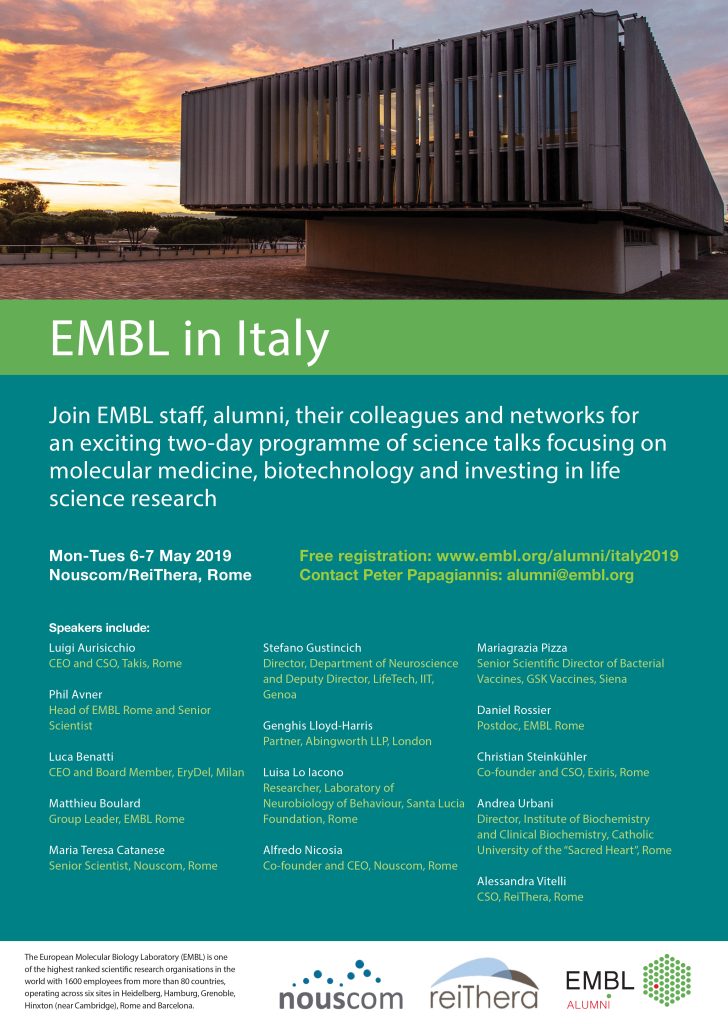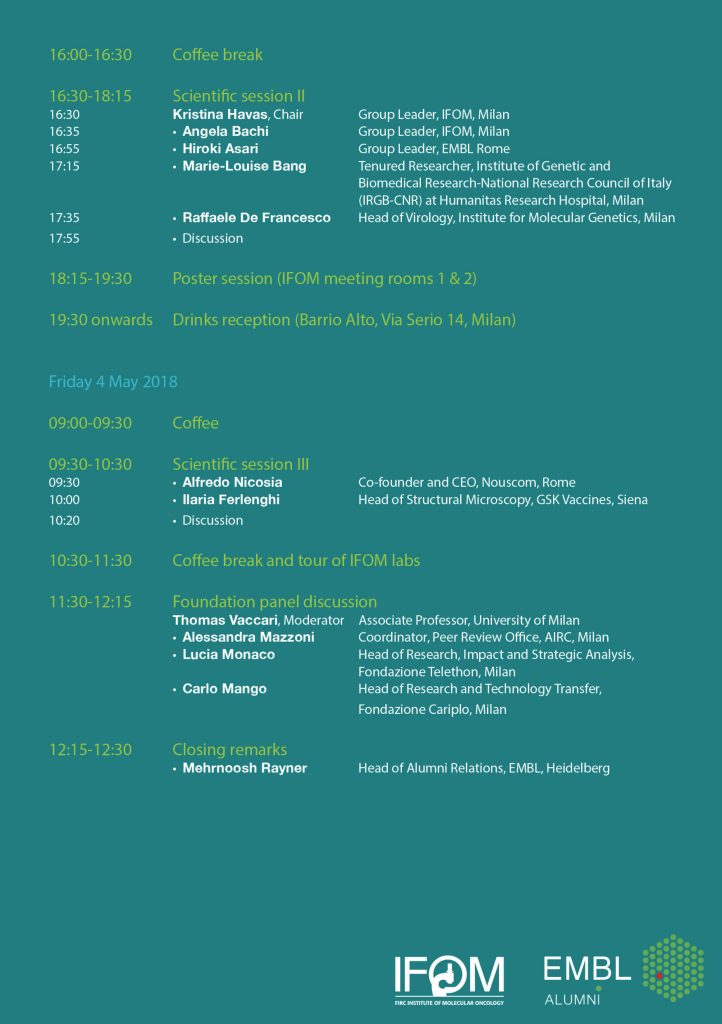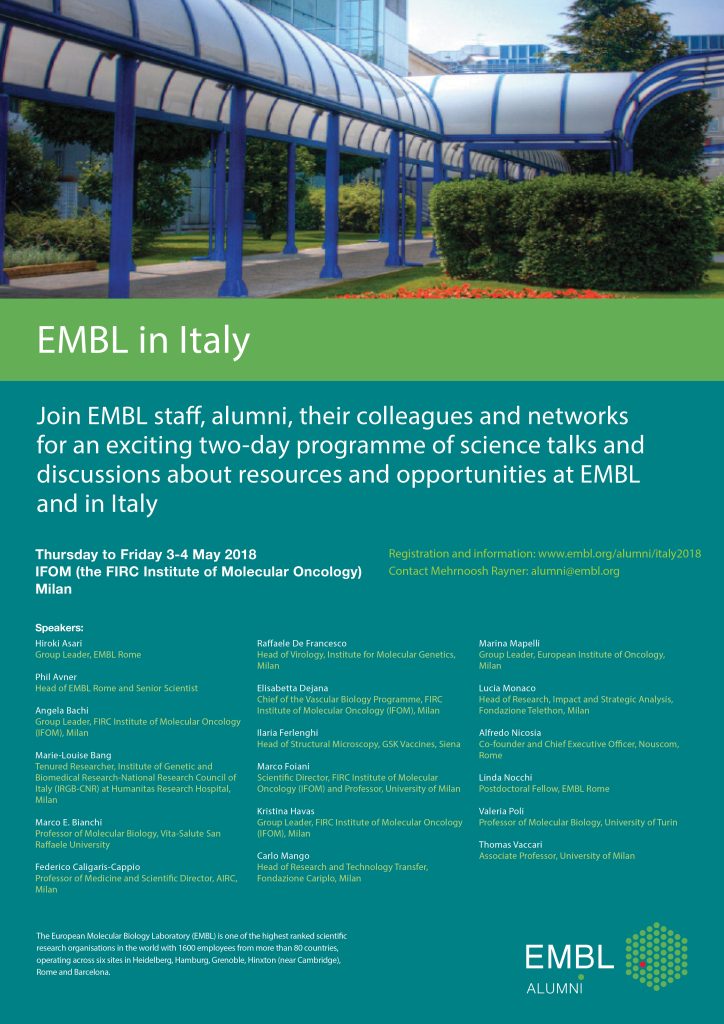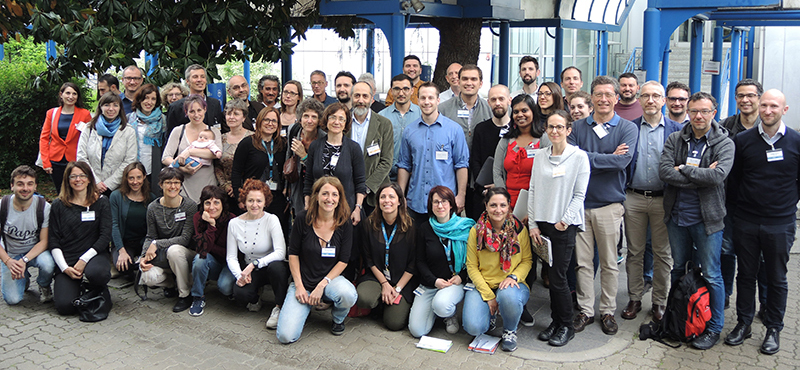
Connecting, engaging and nurturing EMBLs global community of current and former scientists, technicians, communicators and administrators

More than 80 attendees gathered at the EMBL in Italy event at the FIRC Institute of Molecular Oncology (IFOM) in Milan for two days of scientific talks, networking and new insights into funding opportunities.
EMBL alumni from all over Italy came together to give impassioned talks about their time at EMBL, as well as their current scientific work, to scientists at all stages of their careers. The Head of EMBL’s Rome site and co-organiser of the event, Phil Avner, brought his entire faculty to raise awareness of EMBL Rome’s activities. The event was also organised by alumni Kristina Havas-Cavalletti, Group Leader at IFOM, and Thomas Vaccari, Associate Professor at the University of Milan. We met Kristina to ask about her involvement in the event.
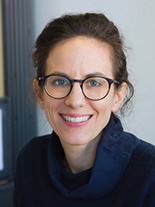
What did you work on during your postdoc?
I was a Postdoc at EMBL Rome from 2012 until 2016, in the lab of Martin Jechlinger, who is now at EMBL Heidelberg. We studied the biological mechanisms behind the recurrence of breast cancer tumours. The five-year survival rates for breast cancer patients are now very good, but the overall survival really hasn’t seen a vast improvement and many women are still succumbing to recurrent tumours. Using mouse models and organoids we characterised a population of dormant tumour cells which were able to survive cancer therapy. We found that there were changes to these cells’ energy metabolism – the way that they take up and use nutrients – and we could use this to predict how the disease might progress.
What does your work involve today?
In the last 18 months I’ve started my own group at IFOM – the Italian Foundation for Cancer Research’s Molecular Oncology Institute. There are many challenges, but it’s also a lot of fun – I have so much freedom and can really develop ideas with my team. One thing which particularly intrigues me from my work at EMBL is the role of fat molecules, or lipids, in the dormant tumour cell population. We’ve been developing methods to study proteins which interact with lipid droplets in these cells. We also want to better understand the interplay between lipid droplets and mitochondria – the cell’s energy powerhouses. We have collaborations with biophysicists, computational biologists and synthetic chemists, so we can take an interdisciplinary approach.
What was the mission of the EMBL in Italy event?
All of these events aim to strengthen ties between EMBL and scientific communities in member states. We want to enlarge networks and share resources. This year the event was held over two days. Together with Thomas Vaccari, we organised a scientific programme that included a poster session to encourage more scientific discourse. This allowed junior researchers and group leaders from IFOM and the surrounding area to attend and speak about their work – increasing the visibility of both EMBL and IFOM, the host institute. Overall the event highlighted how influential EMBL has been in research careers of so many eminent scientists within the alumni community.
How did it feel to be part of the EMBL in Italy event?
It was a great opportunity to meet alumni from the Milan area. It’s a very dynamic community, with a lot of high-level research being conducted by alumni. There’s also a large contingent of women who have come back to Italy and established themselves as group leaders. They’re doing a fantastic job, so seeing them present their work was one of my personal highlights. It was also an emotional reunion for me. The sense of community at EMBL, and particularly at EMBL Rome, makes you feel part of something bigger and more important than your own research, and that is exciting. EMBL is a wonderful place to conduct research. The interdisciplinary nature of the institute provides fertile ground for us to pursue fascinating and unexpected research topics, and that is incredibly special.
At the event, EMBL alumna and speaker Ilaria Ferlenghi spoke about how EMBL’s focus on fundamental research is a springboard for industrial, as well as academic, research careers. We also met with Ilaria to ask about her involvement in the event and her transition from academic to industrial research.
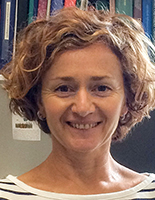
What were you researching during your predoc at EMBL?
I was working at EMBL Heidelberg in the lab of Stephen Fuller, who sadly passed away in 2014. He was a fantastic group leader and a pioneer in the field of cryo-electron microscopy and 3D image reconstruction. During my predoc, I used these techniques to discover the 3D structure of wild type and mutant versions of the Semliki Forest virus. This dangerous virus is carried by mosquitoes and is grouped with viruses that cause dengue fever and tick-borne encephalitis. Although it’s so dangerous, its structure is very beautiful and it gave us important information about how the virus can enter the host cell.
What does your work involve today?
Now I’m the head of Structural Vaccinology at GlaxoSmithKline (GSK). I’m actually still using cryo-electron microscopy and 3D image reconstruction to develop new vaccines against some of the dangerous human diseases such as meningococcus and Respiratory Syncytial Virus. Cryo-electron microscopy is such an important tool and thanks to the Nobel Prize, awarded last year to EMBL alumnus Jacques Dubochet and colleagues, it’s finally being recognised.
What did you gain from your time at EMBL?
EMBL was such an important time in my life. All of the best friends that I had, and still have, come from this period. There was positive competition amongst the predocs, but if you had an issue there was always someone who you could discuss your work with over lunch or a beer. It was a fantastic equilibrium. I have to admit though, it was demanding at times. But this really prepared me for my next steps. When I moved into private industry, I brought creativity and problem-solving skills with me. Also, I don’t only focus on the product – this is something that’s really appreciated at GSK.
How did it feel to be part of this EMBL in Italy event?
It was great, even if it was a bit emotional at the beginning – I didn’t realise so many people that I knew would be there! I enjoyed the atmosphere and the talks, and I met several possible collaborators. At these events you can speak with other scientists about the way they work and be sure that they’re doing excellent science.
I also spoke about my current role and how I got there, highlighting the importance of method development and EMBL’s fundamental research. During a predoc you play with science and you don’t always know if it’s going to be important in the future, but you learn so much in the process. I’m happy that, at least for me, I’ve been able to use the knowledge and skills that I accumulated to save lives.
What will the 2019 EMBL in Italy event involve?
EMBL in Italy 2019 will have a strong industry focus. It’s so important to connect fundamental research and applied industry – and to feedback to each other. I was recently at a conference in the USA with speakers from different industries and it was great for the audience to see how science can be applied. In the end, science is the topic we’re all focussed on, and it has no boundaries.
Emma Steer
Hiroki Asari, Group Leader, EMBL Rom
Phil Avner, Head of EMBL Rome and Senior Scientist
Angela Bachi, Group Leader, FIRC Institute of Molecular Oncology (IFOM), Milan
Marie-Louise Bang, Tenured Researcher, Institute of Genetic and Biomedical Research-National Research Council of Italy (IRGB-CNR) at Humanitas Research Hospital, Milan
Marco E. Bianchi, Professor of Molecular Biology, Vita-Salute San Raffaele University, Milan
Raffaele De Francesco, Head of Virology, Institute for Molecular Genetics, Milan
Elisabetta Dejana, Chief of the Vascular Biology Program, FIRC Institute of Molecular Oncology (IFOM), Milan
Ilaria Ferlenghi, Head of Structural Microscopy, GSK Vaccines, Siena
Marco Foiani, Scientific Director, FIRC Institute of Molecular Oncology (IFOM) and Professor, University of Milan
Kristina Havas, Group Leader, FIRC Institute of Molecular Oncology (IFOM), Milan
Carlo Mango, Head of Research and Technology Transfer, Fondazione Cariplo, Milan
Marina Mapelli, Group Leader, European Institute of Oncology, Milan
Lucia Monaco, Head of Research, Impact and Strategic Analysis, Fondazione Telethon, Milan
Alfredo Nicosia, Co-founder and Chief Executive Officer, Nouscom, Rome
Linda Nocchi, Postdoctoral Fellow, EMBL Rome
Valeria Poli, Professor of Molecular Biology, University of Turin
Thomas Vaccari, Associate Professor, University of Milan
Phil Avner, Head of EMBL Rome and Senior Scientist
Kristina Havas, Group Leader, FIRC Institute of Molecular Oncology (IFOM), Milan
Thomas Vaccari, Associate Professor, University of Milan
